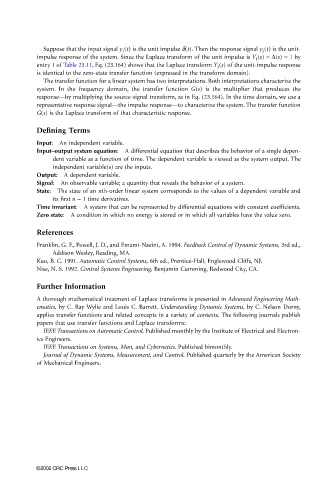Page 752 - The Mechatronics Handbook
P. 752
0066_Frame_C23 Page 60 Wednesday, January 9, 2002 1:56 PM
Suppose that the input signal y 1 (t) is the unit impulse δ(t). Then the response signal y 2 (t) is the unit-
impulse response of the system. Since the Laplace transform of the unit impulse is Y 1 (s) = ∆(s) = 1 by
entry 1 of Table 23.11, Eq. (23.164) shows that the Laplace transform Y 2 (s) of the unit-impulse response
is identical to the zero-state transfer function (expressed in the transform domain).
The transfer function for a linear system has two interpretations. Both interpretations characterize the
system. In the frequency domain, the transfer function G(s) is the multiplier that produces the
response—by multiplying the source-signal transform, as in Eq. (23.164). In the time domain, we use a
representative response signal—the impulse response—to characterize the system. The transfer function
G(s) is the Laplace transform of that characteristic response.
Defining Terms
Input: An independent variable.
Input–output system equation: A differential equation that describes the behavior of a single depen-
dent variable as a function of time. The dependent variable is viewed as the system output. The
independent variable(s) are the inputs.
Output: A dependent variable.
Signal: An observable variable; a quantity that reveals the behavior of a system.
State: The state of an nth-order linear system corresponds to the values of a dependent variable and
its first n − 1 time derivatives.
Time invariant: A system that can be represented by differential equations with constant coefficients.
Zero state: A condition in which no energy is stored or in which all variables have the value zero.
References
Franklin, G. F., Powell, J. D., and Emami-Naeini, A. 1994. Feedback Control of Dynamic Systems, 3rd ed.,
Addison Wesley, Reading, MA.
Kuo, B. C. 1991. Automatic Control Systems, 6th ed., Prentice-Hall, Englewood Cliffs, NJ.
Nise, N. S. 1992. Control Systems Engineering, Benjamin Cumming, Redwood City, CA.
Further Information
A thorough mathematical treatment of Laplace transforms is presented in Advanced Engineering Math-
ematics, by C. Ray Wylie and Louis C. Barrett. Understanding Dynamic Systems, by C. Nelson Dorny,
applies transfer functions and related concepts in a variety of contexts. The following journals publish
papers that use transfer functions and Laplace transforms:
IEEE Transactions on Automatic Control. Published monthly by the Institute of Electrical and Electron-
ics Engineers.
IEEE Transactions on Systems, Man, and Cybernetics. Published bimonthly.
Journal of Dynamic Systems, Measurement, and Control. Published quarterly by the American Society
of Mechanical Engineers.
©2002 CRC Press LLC

